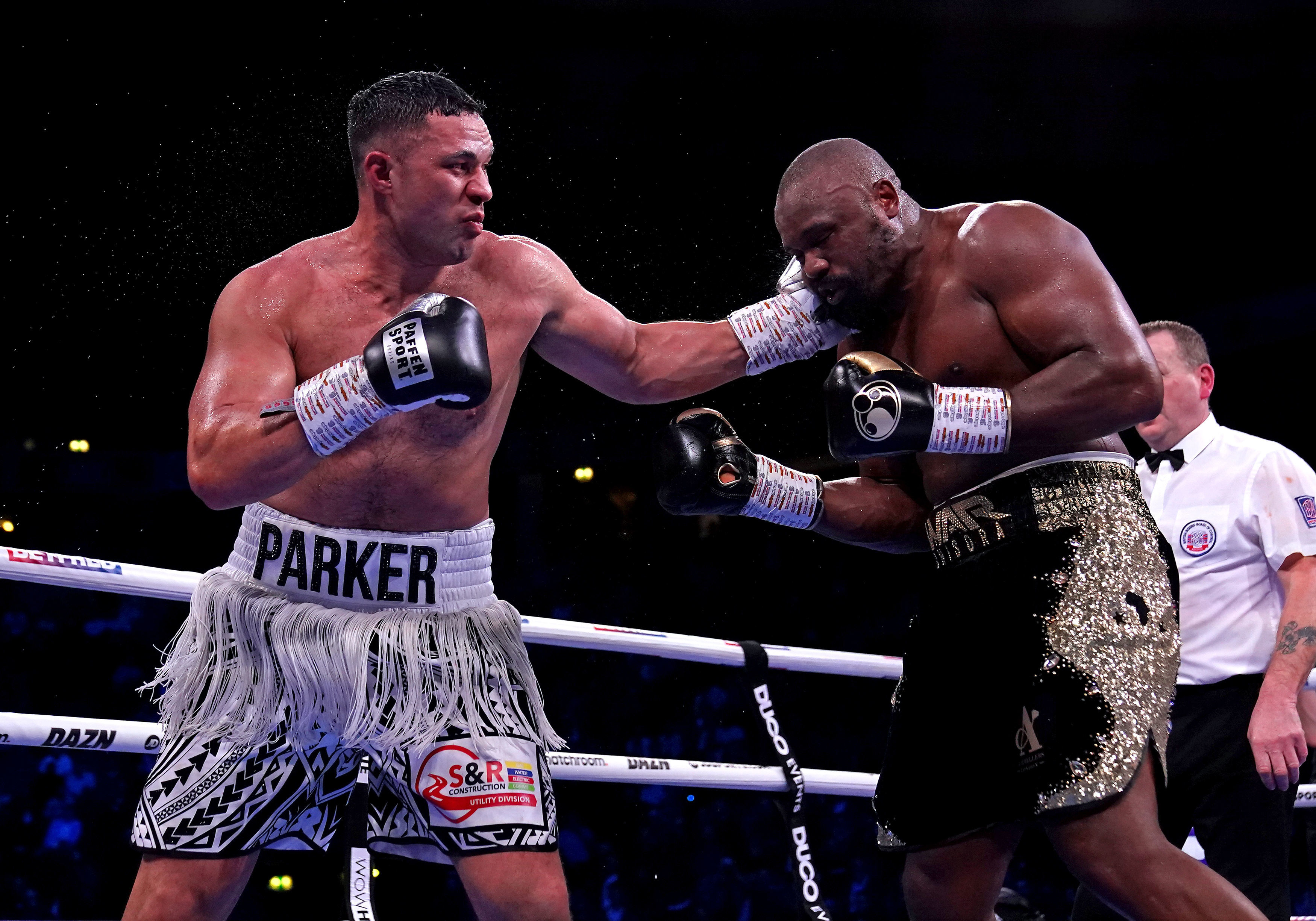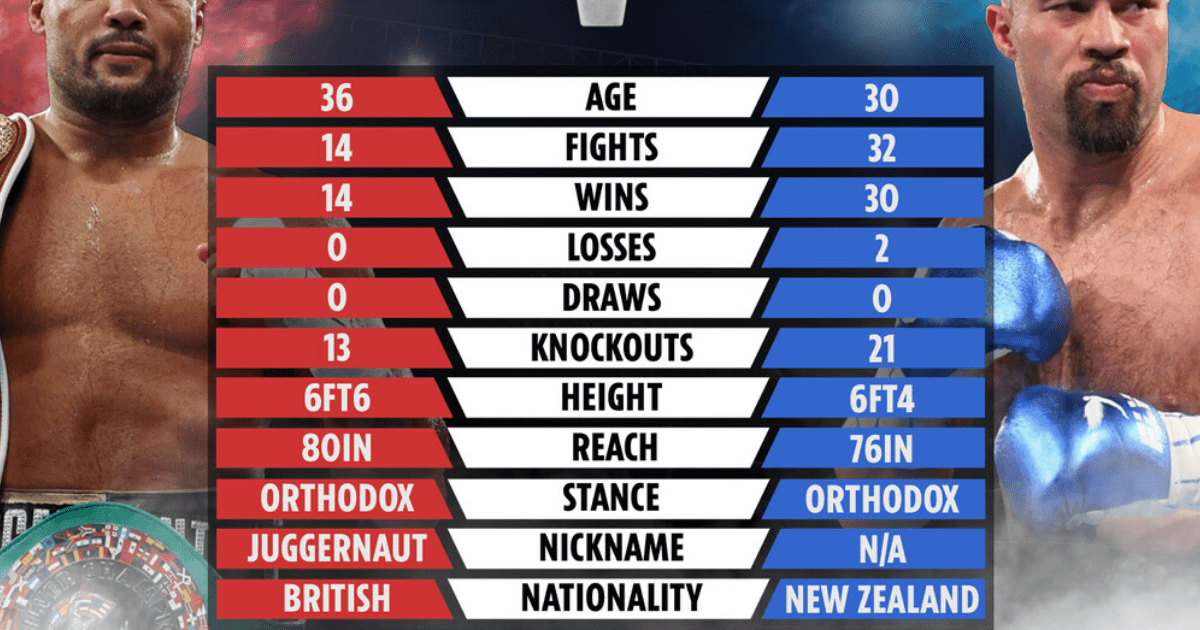JOE JOYCE and Joseph Parker are set to collide at the AO Arena in Manchester on Saturday.
The pair have remained patient for the contest as the fight looked like it would take place in the summer before contract talks broke down.
Joe Joyce is unbeaten and has a height and reach advantage over Joseph Parker
Joyce accused Parker of trying to avoid him

Parker has not fought since beating Derek Chisora in December
Joyce, 36, is fresh from his victory over Christian Hammer in July and is looking to maintain his unbeaten 14-0 record.
Parker has not fought since last December when he defeated Derek Chisora via unanimous decision.
In fact, Joyce is the first new opponent for the Kiwi since he boxed Junior Fa in February 2021, having also fought Chisora in May of that year.
Parker has won his last six fights following back-to-back losses against Anthony Joshua and Dillian Whyte.
Joyce is aiming to become the third British victor over Parker and boasts a height and reach advantage over the 30-year-old.
He also possesses greater knockout power with 93 per cent of his wins coming from KOs compared to Parker’s 66 per cent.
But there is huge pressure on the Juggernaut as a win for either fighter will set up a WBO heavyweight world title fight against Oleksandr Usyk.
That makes it the biggest contest of Joyce’s career since he missed out on superheavyweight gold at the Rio Olympics in 2016.
In the build-up to the fight Joyce has accused Parker of trying to avoid him, referring to the previous breakdown in talks.
The Londoner said: “This fight has been a long time in the making.
“Parker realised he had nowhere else to go and eventually had to take this fight. No 1 vs No 2.
“The winner goes on to fight for the world title! It’s going to be a cracking fight and you will see why he tried so hard to avoid me!”
Parker hit back and promised to show the best he has offer, saying: “On Saturday, September 24th, the fans in Manchester will see the very best of me.
“And Joe Joyce will see exactly why I will become the heavyweight champion of the world again with BOXXER.
“I am working hard with my trainer Andy Lee, everything is going smoothly and I truly feel great.
“I have waited patiently to get this fight on and let me tell you now, the Juggernaut’s journey ends right here. He has nowhere to run.”
Frequently Asked Questions
How to throw a jab
Follow this step-by-step guide to throw a jab.
- Move forward with both your feet.
- Move your arm to the top of your shoulder.
- Your target is at your feet.
- After hitting your target you should swing your arm up.
- Repeat steps 1 to 4.
What is the best way to practice boxing with no partner?
If you’re looking for a partner to practice boxing, you can watch boxing matches on television. You might also be able to find an amateur club nearby. Amateur boxing clubs hold regular training sessions. These sessions usually involve sparring partners who hit pads together.
Punching bags are another option for practicing boxing. Before you hit the bag, make sure to wear protective gear like boxing gloves.
What are the seven punches in boxing
There are seven boxing punches. They include jab and cross, hook and uppercut, straight right and left hook, as well as body shot. These punches can be used to strike the opponent’s head and body.
Statistics
- This article received 39 testimonials and 89% of readers who voted found it helpful, earning it our reader-approved status. (wikihow.com)
- It is just like normal sparring with a partner, but you want to throw punches at 75% of your normal speed. (wikihow.com)
External Links
expertboxing.com
amazon.com
- Amazon.com – Ringside Diablo Wrestling Boxing shoes : Clothing Shoes & Jewelry
- Amazon.com – Sanabul Boxing Wraps Elastic 180in Red — Sports & Outdoors
How To
These are the basic skills of boxing
How to box effectively
Boxing has become a very popular sport. It involves two people who attempt to knock each other out of their heads. Boxing rules vary from one country or another. There are three main types of boxing: Amateur boxing, Professional boxing, and Olympic boxing.
Amateur boxing can be practiced at school or college. This type includes sparring sessions using padded gloves, but without protection. Amateur boxing competitions usually last three rounds and last five minutes each. There are many styles of amateur boxing such as Kickboxing or Muay Thai, Taekwondo and Karate, Judo and Wrestling, among others.
Boxing is typically practiced in clubs, stadiums or gyms. They use protective equipment, such as mouthpieces, nose guards, shin protectors, elbow pads knee pads, waist belts and groin protectors. Professional boxing contests last six rounds and last for four minutes each. There are many styles to professional boxing.
Olympic boxing can be seen at the Olympics. Boxers wear special protective gear, which must conform to international standards. The competition lasts for eight rounds, each lasting three minutes. Olympic boxing has only two styles, Light Flyweight vs Heavyweight.
Boxing’s fundamental skills are:
- Punching techniques
- Guarding techniques
- Footwork
- Stance
- Body movement
- Defense
- Combination
- Rotation
- Sparring
Punching Techniques
There are seven types. Each punch is unique. Some punches need more power than others. For example, an uppercut is a powerful punch. On the other hand, a straight punch requires less power but it is faster than other punches.
There are also different combinations. These are combinations which combine several punches in order to achieve a specific goal. A combination can contain multiple parts. A left hook followed with a right-cross will cause injury to the opponent’s jaw.
Guard Techniques
Boxers use their bodies to defend themselves against attack. He uses his arms, legs, elbows, knees, knees, and feet to do this.
Legs
To defend against kicks, a boxer should use his legs. After receiving a kick, he will raise his leg and move away from the attacker. To avoid being kicked in the side, he bends down if the attacker attacks from the front. If the attack comes from behind, however, he can stand straight up and block the kick by his foot.
Elbows
Elbow strikes are very powerful because they inflict great pain. You can either deliver an elbow strike directly, or indirectly. Directly, you strike your opponent with your forearm. Indirectly, you hit him with another portion of your arm.
Hands
Boxers use their hands as a shield against incoming punches. They raise their fists high above their heads and point them in the direction of an attack. Then, they touch the attacker’s hand.
Knees
To absorb the impact of a punch to the stomach, abdomen, or chest, boxers should bend their knees. For defense purposes, knee strikes are common.
Feet
If he is being attacked, a boxer must take a step back and counter-attack. He can then gain distance from his opponent. Additionally, boxers need to maintain their balance when they counter-attack.
Stances
A boxer must have a stance in order to be effective at boxing. His stance will determine how he defends. It is how he positions himself and where he faces the opponent. Boxers can take many different stances. Here are some of the more popular ones:
- Low stance
- High stance
- Southpaw stance
- Western stance
Moving your body
In order to win a fight, a boxer must move around his opponent. This means changing your speed, position and rhythm.
Rotation
To increase his punching power, a boxer rotates when he throws a punch. The rotation is done at different speeds depending on the type of punch.
Combinations
The timing of each punch determines the effectiveness of a combination. A combination is good if it starts with a strong punch then ends with a weaker one.
Spare parts
Sparring is an exercise session to improve boxing skills. A sparring session is where a boxer trains both his mind and his body. The goal of sparring is to learn to fight, and not to get hurt.
You need to have patience and dedication in order to learn how boxing works. To be a better boxer you need to train hard.

